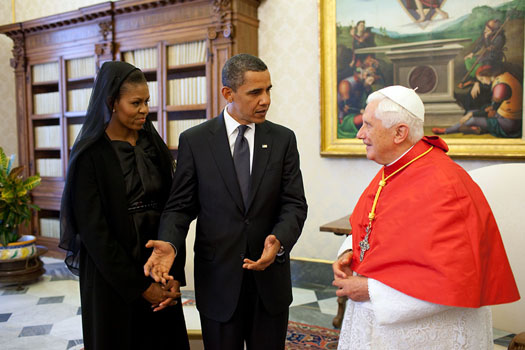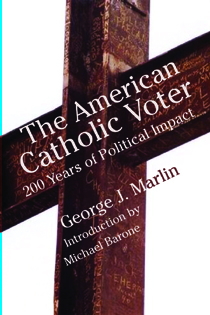 GetReligion readers who frequent the CNN Belief blog know that it features a wide range of material, from hard news stories to essays by academics. A recent offering falls into this latter category, but I still think GetReligion readers will want to know about it since it focuses on a topic that frequently comes up for discussions on this blog.
This commentary piece was written by Stephen S. Schneck, director of the Institute for Policy Research and Catholic Studies at The Catholic University of America, and ran under the headline: "The myth and reality of the Catholic vote." Obviously, this is a topic that is closely related to all of the poll numbers that have been tossed around in the wake of the church-state showdown between the Obama White House and traditional believers in a wide range of faith groups, including traditional Catholics, many Eastern Orthodox leaders, evangelicals, Orthodox Jews and others.
GetReligion readers who frequent the CNN Belief blog know that it features a wide range of material, from hard news stories to essays by academics. A recent offering falls into this latter category, but I still think GetReligion readers will want to know about it since it focuses on a topic that frequently comes up for discussions on this blog.
This commentary piece was written by Stephen S. Schneck, director of the Institute for Policy Research and Catholic Studies at The Catholic University of America, and ran under the headline: "The myth and reality of the Catholic vote." Obviously, this is a topic that is closely related to all of the poll numbers that have been tossed around in the wake of the church-state showdown between the Obama White House and traditional believers in a wide range of faith groups, including traditional Catholics, many Eastern Orthodox leaders, evangelicals, Orthodox Jews and others.
Schneck notes that Catholic voters, whoever they are, are supposed to be the great swing bloc in the American population. There is a problem, however:
... The idea of a Catholic bloc is patently ridiculous. As voters, American Catholics mirror the electorate as a whole, divided into Democrats, independents, and Republicans at about the same percentages as all Americans. And it’s hard to trace such political complexity to religious allegiance.
One explanation for why is the sheer number of Catholic voters and their now multigenerational assimilation into American society. About 35 million Catholics voted in 2008. That’s about 27% of all voters. ...
By finally achieving that assimilation, Catholics in the last 50 years have lost much of their sense of special self-identity. For white Catholics, who are about 60% of the Catholic vote, their distinctiveness in class, education, income and even ethnicity has grown increasingly ambiguous in America’s famous melting pot.
The melting pot has even transformed Catholics’ relationship to their church. Polling numbers released Friday by CNN about the White House contraception dust-up illustrate this: Only 11% of Catholics polled said they should always obey official church teachings on moral issues like birth control and abortion. To put this differently, 88% of Catholics in the poll said that it’s OK for Catholics to make up their own minds about these moral issues. That represents a growing trend. In 1992 only 70% supported the “make up their own minds” argument. In 1999 it was 80%.
This is all pretty standard information. Schneck properly notes that one of the other major realities that must be taken into account -- obviously -- is the growth of the Latino population in Catholic pews here in the United States. Latino Catholics now make up about a third of all American Catholics.
The Latino vote, he concludes, is one of three discreet Catholic votes at play in modern American politics. It is a swing vote that often backs Democrats due to issues of economics and social justice.
Things get more complex when looking at the Anglos, however. For starters, Schneck notes 2011 research from the Pew Forum on Religion and Public Life indicating that one-third of Americans who were raised Catholic have left the church through exit doors both to the secular left and the cultural right. That's a solid 10 percent of the American electorate.
The other two camps of "Catholic voters," he said, can be labeled “intentional Catholics” and “cultural Catholics.” This section of the story must be read carefully.
Some who leave still feel lingering allegiance to things Catholic, but many do not, and former Catholics do not have a distinctive political identity. But as a result of disaffiliation, many Catholics who remain with the church are “distilled.” More and more of those who remain are those who actively choose to embrace the church and its teachings. These “intentional Catholics” are the second of the three important groups of Catholic voters.
Largely white, with impressive education levels, mostly suburban and with moderate to high income levels, such Catholics are in evidence in weekly Mass attendance and parish activities. Politically active, intentional Catholic voters lean toward the Republican Party (with some youthful swing voters) and are motivated by economic issues and increasingly by opposition to abortion, same-sex marriage and illegal immigration.
“Cultural Catholics” make up the third important group of Catholic voters. They are a complicated mix of mostly white Americans with lower levels of Mass attendance and higher levels of ambivalence toward Church authority.
To some degree, it is accurate to note that the "intentional" Catholics are simply more active in the life of the church. This is the old "pew gap" trend in which the more believers attend worship, the more likely they are -- in voting booths -- to be influenced by the so-called "culture war" issues. But does this mean that the "cultural" Catholics can simply be described as progressives?
 Not really, according to Schneck:
Not really, according to Schneck:
Many culturally Catholic voters are at odds with both conservatives and liberals on many issues. They are more socially conservative than the majority of Americans, but many are put off by the more intense social conservatism of intentional Catholics and evangelicals. They are more economically populist than most Americans but are uncomfortable with the libertarian zeal of the tea party. They are alienated from the lifestyle liberalism of many progressives but remain supportive of unions and governmental programs for the middle class.
The bishops may have little role in these voters’ personal faith, but cultural Catholics look to the church for the sacraments that mark the turnings of their lives and for the traditions that connect generations. Their religious sensibility might almost be described as ethnic.
"Ethnic," as opposed to "doctrinal"?
Now, once you have soaked up the professor's take on this, feel free to contrast it with the viewpoint of that veteran K Street priest I interviewed a few years ago who posited four different Catholic votes. When I asked about the Latino vote, he said that he was convinced that there is no one Latino vote, either. In particular, he said that he thought Latinos who are highly active in the church, especially in terms of coming to Confession, tend to lean right on moral and cultural issues.
That grid, you may recall, looks like this:
* Ex-Catholics. Solid for the Democrats. GOP has no chance.
* Cultural Catholics who may go to church a few times a year. This may be an undecided voter -- check out that classic Atlantic Monthly tribes of American religion piece -- depending on what is happening with the economy, foreign policy, etc. Leans to Democrats.
* Sunday-morning American Catholics. This voter is a regular in the pew and may even play some leadership role in the parish. This is the Catholic voter that is really up for grabs, the true swing voter that the candidates are after.
* The “sweats the details” Roman Catholic who goes to confession. Is active in the full sacramental life of the parish and almost always backs the Vatican, when it comes to matters of faith and practice. This is where the GOP has made its big gains in recent decades, but it is a very small slice of the American Catholic pie.
So, read and discuss. The main difference I see is that he has the "active" Catholics in one basic "intentional" group, while my veteran DC priest has them divided two ways, with the "sweats the details" being the only tiny segment of American Catholics who are consistently pro-Vatican day after day, controversy after controversy. Also, note that Schneck has some "ex-Catholics" headed to the right, into evangelical Protestantism.
IMAGE: Official White House photo.
